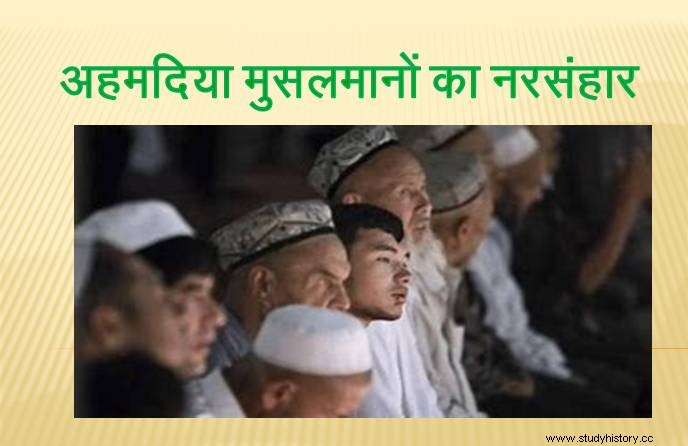
Ahmadiyya Sampradaya is a religious movement, which started on 23 March 1889 in undivided India. The originator of this sect was Mirza Ghulam Ahmed (E.1835-1908). His followers consider Ghulam Ahmed as another prophet and prophet after Muhammad, while according to the beliefs of Islam 'Prophet Mohammed' He is the last prophet sent by God. Ahmadis in Pakistan have been given minority status, not Muslims. They are also called Mirzai Muslims.
Ahmadiyya community appears to be Muslim in Allah, Quran Sharif, prayer, beard, cap, conversation and lifestyle etc. But they do not accept Hazrat Mohammad as their last prophet. They believe that the tradition of Nabu'at (Prophet) continues even now. For this reason people of other Muslim communities collectively strongly oppose this community.
Ahmadiyya Muslims are also called Qadiani because they originated in Qadian town of Gurdaspur district of Punjab. Before India's independence, Muhammad Ali Jinnah was greatly influenced by Ahmadiyya leader Chaudhry Zafarullah Khan's strong arguments in favor of the two-nation theory. Jinnah made Chaudhry Zafarullah Khan the first foreign minister of Pakistan in 1947. After the partition of India, most of the Ahmadiyyas migrated to Pakistan, but after the partition they were subjected to atrocities, which gradually reached their peak. Now the existence of these people is in danger in Pakistan. Ahmadiyyas call themselves Muslims but the law of Pakistan does not consider them to be Muslims.
There were riots against Ahmadis for the first time in Pakistan in AD 1953, in which hundreds of Ahmadiyya Muslims were killed. In 1974, under the leadership of Prime Minister Zulfikar Ali Bhutto, the Pakistani Parliament declared Ahmadis as non-Muslims. This was followed by riots against Ahmadis across Pakistan. Since then this community has been a victim of legal and social discrimination in the Islamic country of Pakistan. They are called Kafirs. When Ahmadiyya Muslims reached Pakistan, they established a separate city for themselves called Rabwa in the Punjab province of Pakistan. More than 50 lakh Ahmadis lived in Rabwa.
In 1974, Sunni fundamentalists looted and set fire to the shops and houses of Ahmadis. Thousands of Ahmadis were killed and several thousand were injured in this violence. Many Ahmadis left Pakistan and went to England after being persecuted by the Pakistani government, Pakistani Muslim society and terrorist organizations. A large group of Ahmadis migrated from Rabwa and started living as refugees on the border of China, the remaining Ahmadis are watching their existence ending by staying within Pakistan.
In the 1980s, when Pakistan's military ruler Ziaul Haq made Pakistan a fully Islamic country, the places of worship of Ahmadis were closed or demolished by the government. Now they cannot call their places of worship as mosques. In 1982, President Zia-ul-Haq again amended the Constitution of Pakistan. Under this, Ahmadis were banned that they could not call themselves Muslims and the death penalty was fixed for insulting the Prophet Muhammad. Their graveyards were separated. Ahmadis' mosques were demolished on government orders. The verses written on their graveyard graves were removed. This led to the exodus of Ahmadis in large numbers.
Thousands of Ahmadis left their country and took refuge in other countries. On 28 May 2010, Taliban militants targeted two Ahmadi mosques in Pakistan. Firing was done at Baitul Noor Mosque in Lahore, grenades were thrown and some terrorists entered the mosque with bombs on their bodies. In this attack 94 people were killed and more than 100 were injured. The second mosque Darul Zikr was also of Lahore.
67 Ahmadis were killed here. Since then, there have been continuous attacks on them. Today there are several crore Ahmadis residing in 206 countries of the world, but in their own country Pakistan, the number of Ahmadis remains only three million. There are 1 million Ahmadiyya Muslims living in India, 2.5 million in Nigeria and about 4 lakh in Indonesia. The largest number of Ahmadiyya Muslims reside in England.
If an Ahmadiyya Muslim in Pakistan is secretly buried in a Sunni cemetery, his body is taken out of both the grave and the cemetery. In the year 2000, the body of Nadia Hanif, a teacher of Chandasingh village, was taken out of the grave for this reason. Similarly, if the name of an Ahmadiyya child is secretly entered in a school, then as soon as he is recognized, he is expelled from the school and he is not admitted to any college or university. A few years ago, Qadiani was added to the name of an Ahmadi student Raheel Ahmed in a high school in a village called Mansera, due to which he was not admitted by any university in Pakistan for further studies.
